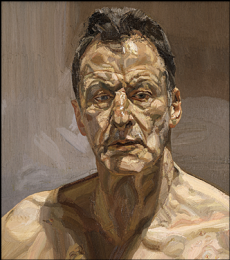

Distortion is the action of distorting or the state of being distorted, pulling or twisting something out of its shape.
This is an exploration of how artists have used distortion in their art to create an atmosphere within their paintings, by investigating the work and techniques of Lucian Freud; how artists have questioned society’s ideals of beauty, by looking closely at the work of Jenny Saville, and how artists have used portraits to explore and stretch their technical expertise, such as through the work of Scott Hutchinson.
Traditionally, the use of portraiture displayed one's physical attributes highlighting their style, place in society and aesthetics. Simply put, portraiture is a representation of how someone looks and is popular among many artists. Indeed, before photography was invented, portraiture was an important tool to show the public what their aristocracy and royalty looked like. Royal portraits would be taken around the country on a ‘progression’ so that people would know what their monarch actually looked like.
Post- 20th-century portraits began to explore emotion, mood and artists’ expression. It is in this period of art history that I have begun to take a keen interest. Through exploring different forms of portraiture, I have looked at various ways in which artists express emotion - not only through facial expression, but through the use of colour, form and composition. I have selected several artists which reflect on the theme of distortion, and have investigated the ways in which artists have used portraits to convey self-expression due to strong feelings towards something or someone.
LUCIAN FREUD
Expressionist Lucian Freud paints what he sees, ‘not what you want him to see’, giving viewers an understanding of his depiction of the human form. Freud’s unique style of using thick brush strokes definitely made a statement; he is an unforgettable artist. His consistent notion to make even the most beautiful people appear ‘ugly’ is an unusual style which captivates his audience. Freud explained that he worked from people that interested him and that he cared about:
“As far as I am concerned the paint is the person. I want it to work for me just as flesh does.”
Freud, being fascinated by those he chose to paint, enhanced the intimacy displayed within his portraits. His creativity and expression influence me to think beyond how paint is used, and to focus on what the art says.
“I've always wanted to create drama in my pictures, which is why I paint people. It's people who have brought drama to pictures from the beginning. The simplest human gestures tell stories.”
Reflection (Self-portrait) 1985
Oil on Canvas
image: https://jamanetwork.com/journals/jamapsychiatry/article-abstract/1685104
This self-portrait brings a dark atmosphere through Freud portraying himself in a cold lusterless way. The colours combined with the straight face reflect on personality and emotion, suggesting that there is a lack of excitement or enthusiasm. I feel like the subject is staring at someone in an unimpressed manner, or the subject is exhausted and has had a long and tiresome day. In contrast to Freud’s other portraits of explicit nudity where the subject matter appears awkward, Freud simply illustrates himself from just below his shoulders upwards. Presenting himself in an unflattering way was a challenge for Freud; being 60 years old when creating this piece he began to assess himself in a more critical way.

0 Comment:
Be the first one to comment on this article.